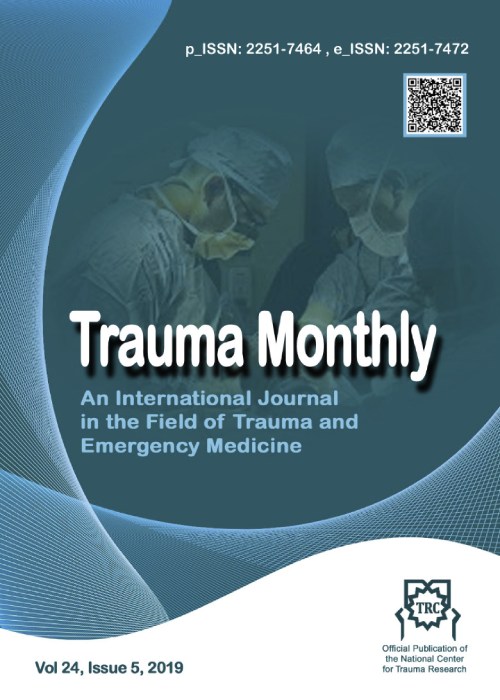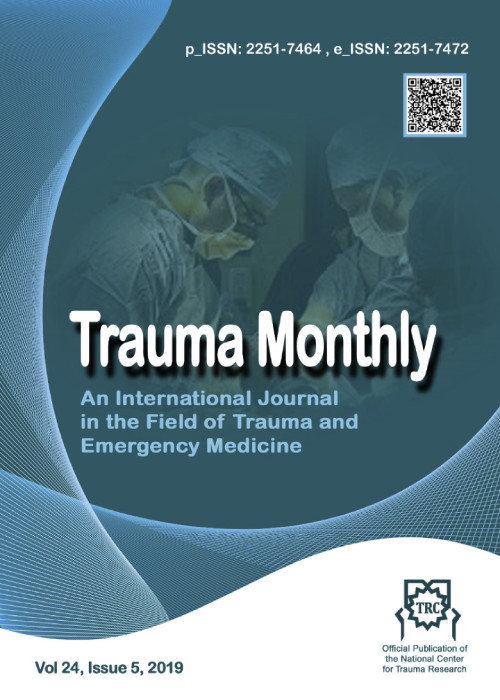فهرست مطالب

Trauma Monthly
Volume:28 Issue: 2, Mar-Apr 2023
- تاریخ انتشار: 1402/04/21
- تعداد عناوین: 7
-
-
Pages 748-760Background
Chronic spinal cord injury has complicated pathophysiology, and current therapies cannot restitute deficits in neurological functions. This review summarizes assembled knowledge of evidence-based medicine and highlights possible challenges.
MethodsReview in systematic reviews refer to the review compiling evidence from several reviews into accessible and usable documents. The PubMed, Google Scholar, and Cochrane Library databases were searched by keywords in title and abstracts for articles satisfying the inclusion criteria through September 30, 2022. Two trained investigators independently performed the critical appraisal of systematic review papers with the PRISMA 2020 checklist.
ResultsThe results were presented in the PRISMA flow diagram. After the exclusion, significant findings resulted in the nine final reviewed studies. The Neuropathology of the chronic phase is determined by the stabilization of the lesion, including white matter demyelination, fibrotic scar, and cystic cavitation. Multiple stem cell types and glial cells are studied in regenerative medicine therapies for chronic spinal cord injury. Also, cell and tissue products, gene therapy products, and xenogeneic cell products are other candidates for clinical applications. Synthetic or natural tissue engineering materials can be implanted in solid scaffolds or injectable in situ forming hydrogels, acting as vehicles for the cells or as vectors of therapeutic agents, or filling the cysts in the case of chronic lesions.
ConclusionCombinatorial therapeutic process that employs cells, biomaterials, and soluble molecules to address different appearances of injury will probably provide the definitive solution by regulating the balance between the inhibitory and excitatory factors implicated in chronic spinal cord injury.
Keywords: review, cell therapy, Biomaterials, Biomolecules -
Pages 761-773IntroductionTrauma-related deaths increase yearly. The distribution of trauma cases is increasing in middle- and low-income countries, and therefore, a national trauma registry system is needed. This study aimed to prioritize the research domains using the data recorded in the National Trauma Registry of Iran (NTRI).MethodThis study used three stages of qualitative and quantitative research methods. First, a detailed literature review was conducted to identify the research domains. Then, appropriate criteria for the priority setting of the study were determined. Finally, scientists and experts of the NTRI ranked the research areas. The data provided by NTRI experts were analyzed based on five scenarios.ResultsBy literature search, 14 main domains using trauma registry data were identified, and six criteria were included in the final modeling phase to prioritize the mentioned domains. According to the NTRI expert opinion, the priority of criteria from highest to lowest was: “effectiveness of interventions performed on patients,” “improving the quality of medical services,” “prevention of trauma,” “Improving economic indicators of the health sector,” “feasibility,” and “importance in science and knowledge production” respectively. Finally, using the multi-criteria decision-making (MCDM) model, “investigating trauma incidence in children and adolescents” and “investigating the relationship between trauma registry data and hospital care protocols” had the highest and lowest average scores, respectively.ConclusionThe results of this study show that, based on the data recorded in NTRI and according to experts’ views, “trauma incidence in children and adolescents, and distribution of trauma based on demographic information” were the most critical areas of research. A complete trauma registry system with an assessment of mentioned domains should be a priority for policymakers.Keywords: Trauma, Disease registration, Research Priority Setting
-
Pages 774-780
Introduction Ileostomy creation is a relatively standard procedure in colorectal surgeries. This study aimed to evaluate the prevalence and severity of dehydration and electrolyte imbalances and find their relationship with patients' demographic and predisposing factors. Methods From April 2018 to February 2020, 256 patients who underwent ileostomy creation surgery in the colorectal ward of Imam Khomeini University Hospital (a tertiary center), Tehran, Iran, were enrolled in this study. All patients underwent standard postoperative care and colorectal nursing care. After the ileostomy started to work, patients were evaluated for daily stoma discharge volume and the serum levels of sodium (Na), potassium(K), Magnesium (Mg), Calcium (Ca), Blood urine Nitrogen(BUN), and Creatinine. Results Of 256 enrolled patients, three died during the first post-operation period. About 88% of ileostomy started working on the first and the second postop days. There were 64(25.2%) patients with HOI during the index admission and 7(2.7%) patients with prolonged hospital stays (> five days P.O.) only because of HOI. The dehydration rate was highest on the 4th P.O. day; then dehydration was highest on the 5th P.O. day, followed by the third day. Altogether there were 108(28.1%) hyponatremia cases in the index admission, with the highest rate on the 4th P.O. day. Altogether, 99 (25.8%) hypokalemia were in the index admission. Conclusion The most prevalent electrolyte imbalance in early PO-readmitted patients was hyponatremia, followed by hypokalemia. Hyperkalemia, hypernatremia, and hypermagnesemia were solely found in readmitted patients and not in the index admission. Early PO readmission with HOI and dehydration was independently associated with Age>60y, Male sex, BMI>30, and living alone status.
Keywords: dehydration, Electrolyte imbalances, Ileostomy -
Pages 781-786
IntroductionInjury to the lateral ankle ligaments caused by inversion of the ankle joint significant lower limb damage. This study aimed to assess patient with chronic lateral instability of the ankle and the return of movement function and stability of their operated ankle using the corrected Brostrom method at Baqiyatallah Hospital.MethodsIn this retrospective study, patients diagnosed with chronic lateral ankle instability from October 2019 to October 2022 were candidates for surgical treatment using the modified Brostrom method at Baqiyatallah Hospital. Information regarding age, gender, occupation of the patient, type of sport, the patient's anterior drawer examination (ADt), American orthopedic foot and ankle society (AOFAS) score, the range of motion (ROM) of the ankle joint, the pain, was recorded before surgery, three months And nine months after the operation.ResultsForty patients were included, and 70% were men. Improvement in the AOFAS scores from pre-operation (55.97±6.97) to 3 and 9 months after surgery (73.60±7.07 and 90.27±8.57) was significant (P < 0.001), and also, the AOFAS scores significantly improved between the 3 and 9 follow-ups (P < 0.001). The decrease in the pain was significant between pre-operation and three and nine follow-ups and also significantly reduced between the three-month follow-up and the nine-month follow-up (P< 0.001). The increase in the ROM was significant between pre-operation and three and nine follow-ups (P<0.001). There were significant differences between preoperation and 3-month and 9-month follow-ups after surgery in ADT and sprain (P<0.001).ConclusionThis study showed that significant improvements in the AOFAS scale, pain, ROM, ADT, and sprain modified Broström repair could cause satisfactory results.
Keywords: Modified Brostrom Repair, Pain, Functional Improvement -
Pages 787-792Introduction
War-zone injuries are creating PTSD. This study aimed to assess Posttraumatic stress disorder (PTSD) Following Traumatic injuries among the Military Populations.
MethodsPubMed, Scopus, Web of Science, and Google Scholar sites were searched from 2013 to 2023. Two authors separately screened, assessed, and included the studies and any disagreement resolved by senior reviewers.
ResultsFifteen studies were included. Mental disorders among the forces showed that diseases, such as PTSD, were the highest among the military forces. The PTSD proportion in TBI cases was more significant than those without TBI. The cause of injuries and PTSD outcomes was due to blast injuries.
ConclusionPTSD is among military force personnel's most common mental health disorders. Therefore, measures must be taken to prevent and control these diseases, especially among military combat forces. Classifying mental health disorders based on gender, age, the type of military service, the location of troops, the military rank of individuals, and the relationship with PTSD require further studies.
Keywords: PTSD, Military, Trauma -
Pages 793-802
IntroductionThis study aimed to compare the improvement of the activity content and pain reduction in patients with patella displacement after total knee arthroplasty surgery with and without correction. MethodsThis study was conducted on all patients over 18 years of age refer to Baqiyatallah Hospital suffering from patella displacement, on patellar view radiography, were candidates for knee joint replacement, and underwent joint replacement. Thirty-five patients with deviation and required removal of the patella bone, whose problem was corrected after total knee joint replacement, with 35 patients whose deviation and displacement of the patellar bone was not restored after total knee joint replacement. Reducing the VAS and improve the range of motion (ROM) was assessed in the follow-up periods of 1, 2, and 4 months postoperative. Evaluation of the presence of deviation and displacement of the patella and its correction was done based on the radiograph of the patella view at an angle of 90 degrees.ResultsIn examining the range of motion, the results showed that the patients in the cases and control before surgery had no significant difference in the range of motion (P=0.001). This is while a statistically significant difference was reported in the patient's range of motion between the two groups at one month, two months, and four months after surgery (P=0.001). The average pain before surgery was similar in the two groups (P=0.953). The average pain in one, two, and four months after surgery in the modified group was lower than in the non-modified group (P=0.001).ConclusionThis study showed that the range of motion in the modified group was higher one month, two months, and four months after surgery. Also, the average pain one, two, and four months after surgery in the modified group was lower than in the unmodified group.
Keywords: Patellar bone deviation, the range of motion, total knee arthroplasty surgery -
Pages 803-804
Trauma is one of the main cause of death and one of the leading causes of disability in most countries, especially in developing countries. Due to the increase in annual death statistics in this area, especially among young people, the need to improve the trauma management and treatment system in different ways, such as using medical equipment equipped with new technologies such as artificial intelligence, is raised. Finally, the result of this approach will be to update and improve treatment and rehabilitation methods for trauma victims and speed up their health recovery, especially in the case of military traumas. The primary approach of combining artificial intelligence with Treatment aims to increase the speed, success, and quality of management of trauma victims.
Keywords: Artificial intelligence, Critical Care, Radiology


